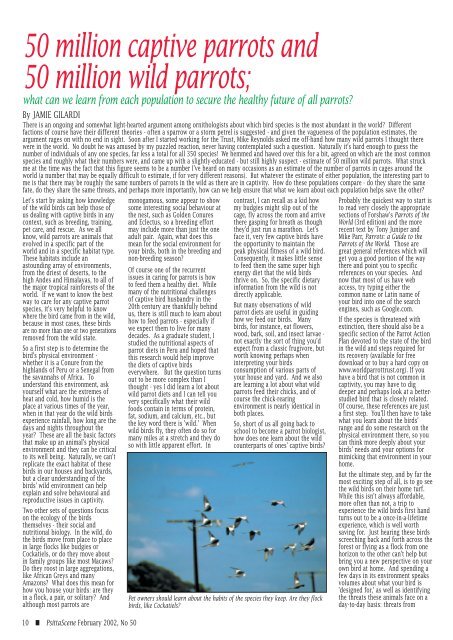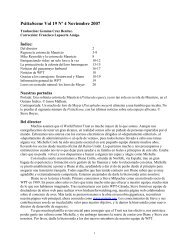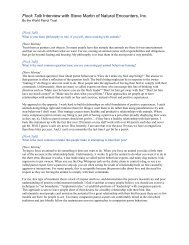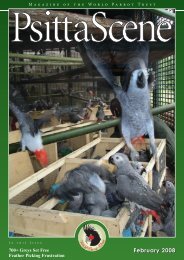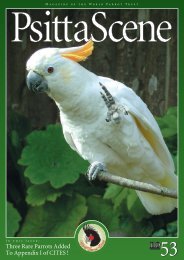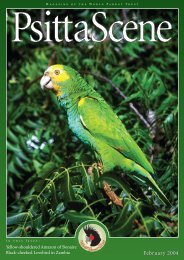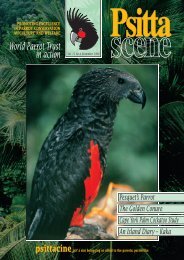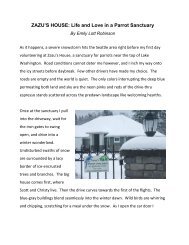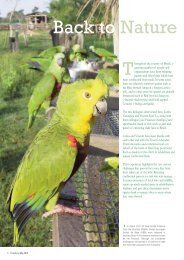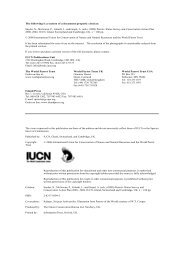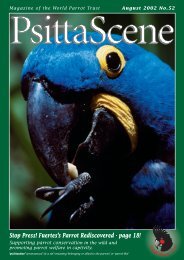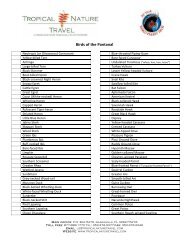Celebrating our 50th Issue! - World Parrot Trust
Celebrating our 50th Issue! - World Parrot Trust
Celebrating our 50th Issue! - World Parrot Trust
Create successful ePaper yourself
Turn your PDF publications into a flip-book with our unique Google optimized e-Paper software.
50 million captive parrots and<br />
50 million wild parrots;<br />
what can we learn from each population to secure the healthy future of all parrots?<br />
By JAMIE GILARDI<br />
There is an ongoing and somewhat light-hearted argument among ornithologists about which bird species is the most abundant in the world? Different<br />
factions of c<strong>our</strong>se have their different theories - often a sparrow or a storm petrel is suggested - and given the vagueness of the population estimates, the<br />
argument rages on with no end in sight. Soon after I started working for the <strong>Trust</strong>, Mike Reynolds asked me off-hand how many wild parrots I thought there<br />
were in the world. No doubt he was amused by my puzzled reaction, never having contemplated such a question. Naturally it's hard enough to guess the<br />
number of individuals of any one species, far less a total for all 350 species! We hemmed and hawed over this for a bit, agreed on which are the most common<br />
species and roughly what their numbers were, and came up with a slightly-educated - but still highly suspect - estimate of 50 million wild parrots. What struck<br />
me at the time was the fact that this figure seems to be a number I've heard on many occasions as an estimate of the number of parrots in cages around the<br />
world (a number that may be equally difficult to estimate, if for very different reasons). But whatever the estimate of either population, the interesting part to<br />
me is that there may be roughly the same numbers of parrots in the wild as there are in captivity. How do these populations compare - do they share the same<br />
fate, do they share the same threats, and perhaps more importantly, how can we help ensure that what we learn about each population helps save the other?<br />
Let's start by asking how knowledge<br />
of the wild birds can help those of<br />
us dealing with captive birds in any<br />
context, such as breeding, training,<br />
pet care, and rescue. As we all<br />
know, wild parrots are animals that<br />
evolved in a specific part of the<br />
world and in a specific habitat type.<br />
These habitats include an<br />
astounding array of environments,<br />
from the driest of deserts, to the<br />
high Andes and Himalayas, to all of<br />
the major tropical rainforests of the<br />
world. If we want to know the best<br />
way to care for any captive parrot<br />
species, it's very helpful to know<br />
where the bird came from in the wild,<br />
because in most cases, these birds<br />
are no more than one or two generations<br />
removed from the wild state.<br />
So a first step is to determine the<br />
bird's physical environment -<br />
whether it is a Conure from the<br />
highlands of Peru or a Senegal from<br />
the savannahs of Africa. To<br />
understand this environment, ask<br />
y<strong>our</strong>self what are the extremes of<br />
heat and cold, how humid is the<br />
place at various times of the year,<br />
when in that year do the wild birds<br />
experience rainfall, how long are the<br />
days and nights throughout the<br />
year? These are all the basic factors<br />
that make up an animal's physical<br />
environment and they can be critical<br />
to its well being. Naturally, we can't<br />
replicate the exact habitat of these<br />
birds in <strong>our</strong> houses and backyards,<br />
but a clear understanding of the<br />
birds' wild environment can help<br />
explain and solve behavi<strong>our</strong>al and<br />
reproductive issues in captivity.<br />
Two other sets of questions focus<br />
on the ecology of the birds<br />
themselves - their social and<br />
nutritional biology. In the wild, do<br />
the birds move from place to place<br />
in large flocks like budgies or<br />
Cockatiels, or do they move about<br />
in family groups like most Macaws?<br />
Do they roost in large aggregations,<br />
like African Greys and many<br />
Amazons? What does this mean for<br />
how you house y<strong>our</strong> birds: are they<br />
in a flock, a pair, or solitary? And<br />
although most parrots are<br />
10 ■ PsittaScene February 2002, No 50<br />
monogamous, some appear to show<br />
some interesting social behavi<strong>our</strong> at<br />
the nest, such as Golden Conures<br />
and Eclectus, so a breeding effort<br />
may include more than just the one<br />
adult pair. Again, what does this<br />
mean for the social environment for<br />
y<strong>our</strong> birds, both in the breeding and<br />
non-breeding season?<br />
Of c<strong>our</strong>se one of the recurrent<br />
issues in caring for parrots is how<br />
to feed them a healthy diet. While<br />
many of the nutritional challenges<br />
of captive bird husbandry in the<br />
20th century are thankfully behind<br />
us, there is still much to learn about<br />
how to feed parrots - especially if<br />
we expect them to live for many<br />
decades. As a graduate student, I<br />
studied the nutritional aspects of<br />
parrot diets in Peru and hoped that<br />
this research would help improve<br />
the diets of captive birds<br />
everywhere. But the question turns<br />
out to be more complex than I<br />
thought - yes I did learn a lot about<br />
wild parrot diets and I can tell you<br />
very specifically what their wild<br />
foods contain in terms of protein,<br />
fat, sodium, and calcium, etc., but<br />
the key word there is 'wild.' When<br />
wild birds fly, they often do so for<br />
many miles at a stretch and they do<br />
so with little apparent effort. In<br />
contrast, I can recall as a kid how<br />
my budgies might slip out of the<br />
cage, fly across the room and arrive<br />
there gasping for breath as though<br />
they'd just run a marathon. Let's<br />
face it, very few captive birds have<br />
the opportunity to maintain the<br />
peak physical fitness of a wild bird.<br />
Consequently, it makes little sense<br />
to feed them the same super high<br />
energy diet that the wild birds<br />
thrive on. So, the specific dietary<br />
information from the wild is not<br />
directly applicable.<br />
But many observations of wild<br />
parrot diets are useful in guiding<br />
how we feed <strong>our</strong> birds. Many<br />
birds, for instance, eat flowers,<br />
wood, bark, soil, and insect larvae -<br />
not exactly the sort of thing you'd<br />
expect from a classic frugivore, but<br />
worth knowing perhaps when<br />
interpreting y<strong>our</strong> birds<br />
consumption of various parts of<br />
y<strong>our</strong> house and yard. And we also<br />
are learning a lot about what wild<br />
parrots feed their chicks, and of<br />
c<strong>our</strong>se the chick-rearing<br />
environment is nearly identical in<br />
both places.<br />
So, short of us all going back to<br />
school to become a parrot biologist,<br />
how does one learn about the wild<br />
counterparts of ones' captive birds?<br />
Pet owners should learn about the habits of the species they keep. Are they flock<br />
birds, like Cockatiels?<br />
Probably the quickest way to start is<br />
to read very closely the appropriate<br />
sections of Forshaw's <strong>Parrot</strong>s of the<br />
<strong>World</strong> (3rd edition) and the more<br />
recent text by Tony Juniper and<br />
Mike Parr, <strong>Parrot</strong>s: a Guide to the<br />
<strong>Parrot</strong>s of the <strong>World</strong>. Those are<br />
great general references which will<br />
get you a good portion of the way<br />
there and point you to specific<br />
references on y<strong>our</strong> species. And<br />
now that most of us have web<br />
access, try typing either the<br />
common name or Latin name of<br />
y<strong>our</strong> bird into one of the search<br />
engines, such as Google.com.<br />
If the species is threatened with<br />
extinction, there should also be a<br />
specific section of the <strong>Parrot</strong> Action<br />
Plan devoted to the state of the bird<br />
in the wild and steps required for<br />
its recovery (available for free<br />
download or to buy a hard copy on<br />
www.worldparrottrust.org). If you<br />
have a bird that is not common in<br />
captivity, you may have to dig<br />
deeper and perhaps look at a betterstudied<br />
bird that is closely related.<br />
Of c<strong>our</strong>se, these references are just<br />
a first step. You'll then have to take<br />
what you learn about the birds'<br />
range and do some research on the<br />
physical environment there, so you<br />
can think more deeply about y<strong>our</strong><br />
birds' needs and y<strong>our</strong> options for<br />
mimicking that environment in y<strong>our</strong><br />
home.<br />
But the ultimate step, and by far the<br />
most exciting step of all, is to go see<br />
the wild birds on their home turf.<br />
While this isn't always affordable,<br />
more often than not, a trip to<br />
experience the wild birds first hand<br />
turns out to be a once-in-a-lifetime<br />
experience, which is well worth<br />
saving for. Just hearing these birds<br />
screeching back and forth across the<br />
forest or flying as a flock from one<br />
horizon to the other can't help but<br />
bring you a new perspective on y<strong>our</strong><br />
own bird at home. And spending a<br />
few days in its environment speaks<br />
volumes about what y<strong>our</strong> bird is<br />
'designed for,' as well as identifying<br />
the threats these animals face on a<br />
day-to-day basis: threats from


